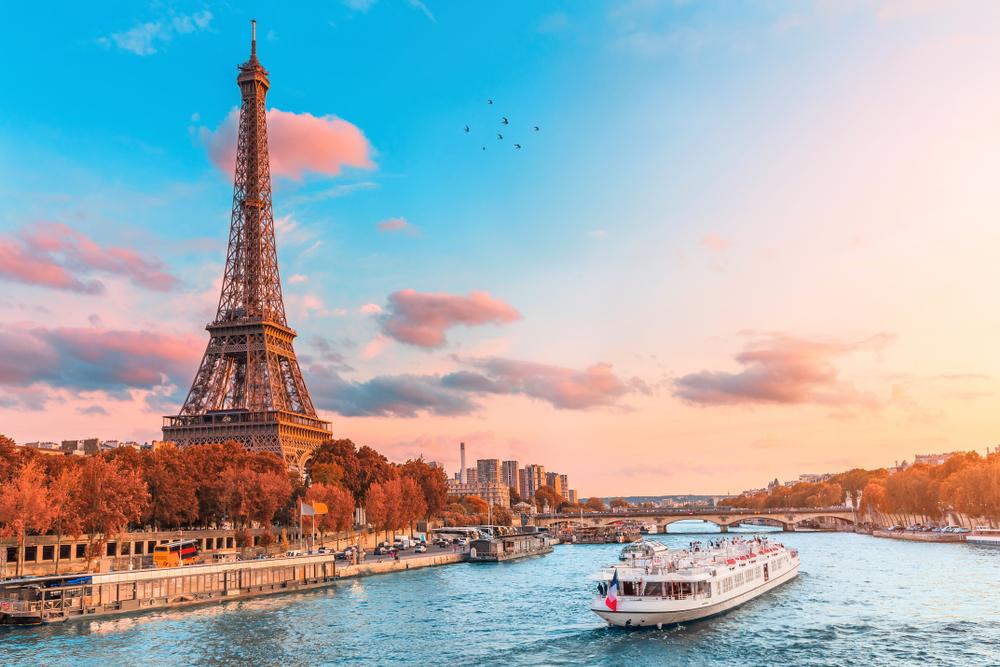Discover the allure of Europe through its top destinations that promise unforgettable experiences. Paris enchants with the Eiffel Tower and artistic treasures, while Rome’s history resonates through the Colosseum and Vatican City. Barcelona captivates with Gaudí’s architecture and vibrant culture, and Santorini offers stunning sunsets over white-washed landscapes. Amsterdam’s canals and museums beckon, while Prague’s spires and charm create a fairy-tale setting. Venice’s canals and romantic ambiance enchant, and Dubrovnik’s coastal beauty and history intrigue. The Swiss Alps offer awe-inspiring natural beauty, and Edinburgh’s mix of history and culture captivates. These places encapsulate Europe’s rich diversity, ensuring an unforgettable travel experience.
Van Gogh Museum, Amsterdam:
The Van Gogh Museum, located in Amsterdam, Netherlands, is a haven for art enthusiasts and admirers of Vincent van Gogh’s extraordinary work. The museum houses the largest collection of artworks by the Dutch post-impressionist master, including his iconic paintings like “Sunflowers,” “Starry Night,” and “The Bedroom.” Visitors to the Van Gogh Museum are treated to an immersive journey through the life and artistic evolution of Vincent van Gogh. The museum’s carefully curated exhibitions trace his career, from his early works to his later masterpieces. Alongside his paintings, the museum also features an impressive collection of his sketches, letters, and personal effects, offering insights into his creative process and personal struggles. Van Gogh’s passionate use of color, bold brushstrokes, and unique artistic vision come to life within the museum’s galleries. The experience provides an intimate connection with the artist’s emotions, inspirations, and the evolution of his style. Obtaining Van Gogh Museum tickets offers visitors the opportunity to explore this treasure trove of artistic brilliance.
St. Mark’s Basilica, Venice:
St. Mark’s Basilica, an exquisite masterpiece of Byzantine architecture, stands as a symbol of Venice’s grandeur and cultural heritage. Located in St. Mark’s Square, this basilica showcases a captivating fusion of Eastern and Western influences, reflecting Venice’s historical role as a vibrant trading hub. The interior of St. Mark’s Basilica is adorned with intricate mosaics that depict biblical scenes and religious figures. The golden mosaics that cover the walls and domes create a mesmerizing and ethereal atmosphere, reflecting the opulence and spiritual significance of the basilica. St Mark’s Basilica tickets allow visitors to explore this architectural gem and delve into its history. The ticketed entry provides access to the basilica’s awe-inspiring interior, as well as the opportunity to ascend to the balcony for panoramic views of St. Mark’s Square and the surrounding cityscape.
Eiffel Tower, Paris:
The Eiffel Tower, an iconic symbol of Paris and one of the most recognized landmarks in the world, stands as a testament to architectural elegance and human innovation. Designed by Gustave Eiffel and completed in 1889 for the World’s Fair, this towering structure initially met mixed reactions but has since become an enduring emblem of the city’s romantic charm.
The Eiffel Tower’s intricate lattice of iron girders and its distinctive silhouette against the Parisian skyline create a breathtaking sight. The tower’s design showcases a harmonious blend of form and function, with observation decks at different heights that offer panoramic views of the city’s iconic landmarks. Visitors can ascend the tower via elevators or a climb up its gracefully curved staircases. Each level offers unique perspectives of Paris, from the bustling streets below to the majestic Seine River and landmarks like the Arc de Triomphe and Notre-Dame Cathedral.
Sagrada Família, Barcelona:
The Sagrada Família, an awe-inspiring masterpiece in the heart of Barcelona, stands as a testament to the genius of architect Antoni Gaudí and his unique vision. This basilica, dedicated to the Holy Family, is characterized by its surreal and otherworldly architecture, seamlessly blending Gothic and Art Nouveau elements into a breathtaking whole. Construction of the Sagrada Família began in 1882 and continues to this day, with completion expected in the coming years. Gaudí’s design draws inspiration from nature, with intricate facades depicting biblical scenes, symbolism, and an abundance of organic forms. The basilica’s interior is a symphony of light and color, with towering columns resembling trees and an ethereal atmosphere that creates a sense of spiritual reverence. The Sagrada Família’s Nativity Facade and Passion Facade tell the story of Christ’s birth and crucifixion, while the Glory Facade, still under construction, will depict the end of times and human salvation. The basilica’s soaring spires are a testament to Gaudí’s ambition, with the central spire set to be the tallest when complete.
Oia Winding Streets,Santorini:
Oia’s winding streets in Santorini, Greece, offer an enchanting journey through a maze of narrow, cobblestone pathways that wind their way through this iconic cliffside village. Adorned with white-washed buildings, vibrant blue domes, and stunning bougainvillaea blooms, these charming streets exude the essence of traditional Greek architecture and culture. As you meander through the labyrinthine alleys, each twist and turn reveals new vistas of the cerulean Aegean Sea, creating a sense of wonder and discovery around every corner. The interplay of sunlight and shade casts a captivating dance of colors and textures, making every step a visual delight. Whether you’re searching for hidden boutiques, art galleries, or the perfect spot to capture a mesmerizing sunset, Oia’s winding streets offer an unforgettable journey that captures the essence of the Greek islands’ allure.
Prague Castle, Czech Republic:
Prague Castle, a majestic complex that overlooks the city of Prague, is a historical treasure trove and a symbol of Czech heritage. This sprawling fortress, perched on a hill above the Vltava River, is one of the largest castle complexes in the world and a UNESCO World Heritage site. The castle’s history dates back over a thousand years, with its architectural elements representing a fusion of styles, from Romanesque to Gothic and Baroque. The monumental St. Vitus Cathedral, situated within the castle complex, is a prime example of Gothic architecture, with its intricate stained glass windows and soaring spires. The castle’s various courtyards, palaces, and gardens offer a glimpse into Czech history and royalty. The Old Royal Palace, the residence of Bohemian kings, boasts the Vladislav Hall, where royal events and celebrations took place. The Golden Lane, a charming row of colorful houses, provides insight into the daily lives of castle inhabitants over the centuries.
Hohematte Park, Switzerland:
Hohematte Park in Interlaken, Switzerland, is a picturesque and charming haven that encapsulates the natural beauty and tranquility of the Swiss Alps. This expansive park, nestled between the two crystal-clear lakes of Thun and Brienz, offers an idyllic setting where visitors can immerse themselves in the serene Alpine landscape. With its manicured lawns, vibrant flower beds, and stunning views of the surrounding mountains, Hohematte Park provides a perfect spot for leisurely strolls, picnics, and relaxing moments. Whether it’s basking in the sun, capturing postcard-worthy photographs, or simply unwinding amidst nature’s embrace, Hohematte Park presents a harmonious blend of Swiss elegance and the splendor of the outdoors.
Edinburgh Castle, Scotland:
Edinburgh Castle, an iconic fortress that overlooks the city of Edinburgh, Scotland, stands as a historic and cultural symbol that spans centuries of Scottish history. Perched atop Castle Rock, this formidable structure has witnessed royal ceremonies, battles, and the evolution of the nation. The castle’s complex includes a range of architectural wonders, from the medieval St. Margaret’s Chapel, one of the oldest surviving buildings in Edinburgh, to the Great Hall, adorned with intricate woodwork and heraldic displays. The Crown Jewels of Scotland, including the crown, scepter, and sword, are on display in the Crown Room. The castle’s Half Moon Battery and One O’Clock Gun pay homage to its military past, while the National War Museum delves into Scotland’s military heritage. The Stone of Destiny, a historic symbol of Scottish sovereignty, is also housed within the castle.
Dubrovnik Cathedral, Croatia
The Dubrovnik Cathedral, also known as the Cathedral of the Assumption of the Virgin Mary, is a significant religious and architectural landmark in Dubrovnik, Croatia. This stunning Baroque cathedral stands as a testament to the city’s history, culture, and faith. Built in the 18th century, the Dubrovnik Cathedral features an impressive facade adorned with ornate sculptures and intricate details. The interior boasts a rich artistic heritage, with elaborate altars, marble columns, and magnificent paintings by renowned artists like Titian and Giuseppe Sacconi. One of the most revered relics in the cathedral is the Treasury, which houses a collection of valuable religious artifacts, including gold and silver pieces, reliquaries, and sacred objects. The highlight of the Treasury is the famous Reliquary of St. Blaise, the patron saint of Dubrovnik.
Anne Frank House, Amsterdam:
The Anne Frank House, located in Amsterdam, serves as a poignant testament to one of the most compelling stories of the Holocaust. This museum is housed in the actual building where Anne Frank, a Jewish girl, and her family went into hiding during World War II to escape Nazi persecution. The museum’s core is the concealed annex, where Anne Frank and her family, along with another family, lived in secrecy for over two years. Anne documented her experiences and thoughts in a diary, which later became a powerful literary work that resonates with readers worldwide. Visiting the Anne Frank House provides a deeply moving and somber experience. Walking through the hidden rooms, preserved with authenticity, allows visitors to grasp the challenges, fears, and hopes of those who lived in confinement. The museum also presents exhibits about the historical context of the Holocaust, promoting awareness and understanding.


